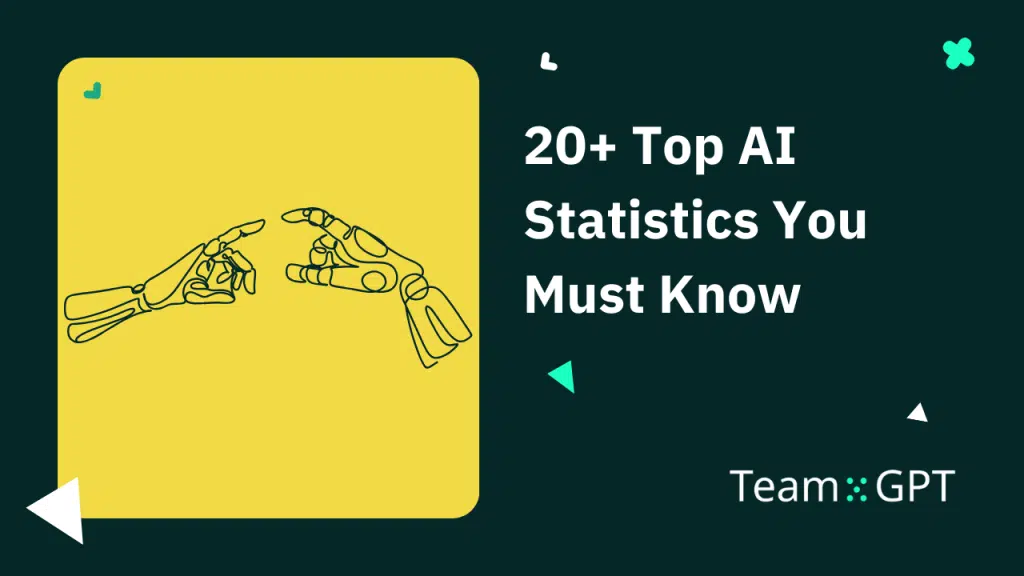After OpenAI’s launch, the market size of artificial intelligence has grown tremendously. Not only have people started using AI, but the investment in the sector has also skyrocketed.
It’s like everyone on the planet now knows what AI and machine learning is.
This article will walk you through different categories of AI statistics:
- Market size and growth
- Adoption and implementation of AI
- AI’s impact on marketing and customer service
- Investment in AI R&D
- Ethical and legal considerations
- Consumer attitudes towards AI
- Environmental impact of AI
But first, here are the top statistics worth looking at. 👇
- Editor’s Pick – Artificial Intelligence Statistics
- Artificial Intelligence Stats for Market Size and Growth
- AI Adoption and Implementation
- AI’s Impact on Marketing and Customer Service
- Investment in AI R&D
- Ethical and Legal Considerations
- Consumer Attitudes Towards AI
- Environmental Impact of AI
- Key Takeaways
Editor’s Pick – Artificial Intelligence Statistics
✅ Currently, the market size is ~200 billion US dollars and is expected to grow to ~2 trillion US dollars by 2030.
✅ The US is the biggest AI player in the world. In 2023, the US market size accounted for 123.1 billion US dollars.
According to TechJury, the global AI adoption rate grew steadily and is now at 35%, a four-point increase from 2021.
✅ 61.4% of marketers have used AI in their marketing activities.
✅ The IT leaders are actively using AI as it’s helping them improve customer relationships by serving their customers accurately and fast.
✅ According to Goldman Sachs economists Joseph Briggs and Devesh Kodn, global AI investments are expected to reach $200 billion by 2025.
✅ As per Forbes, businesses are using AI across a wide range of areas, with the highest adoption rate in customer service (56%) and cybersecurity (51%).
Artificial Intelligence Stats for Market Size and Growth
#1. AI Market Size Worldwide
According to Statista, the AI market is expected to grow rapidly in the coming decade. Currently, the market size is ~200 billion US dollars and is expected to grow to ~2 trillion US dollars by 2030.
The AI market covers a vast number of industries. Everything from supply chains, marketing, product making, research, analysis, and more, in some aspects, adopt artificial intelligence within their business structures.
Chatbots, image-generating AI, and mobile applications are all among the major trends in improving AI in the coming years.
#2. Major Driver of the AI Market – ChatGPT
ChatGPT played a major role in the AI market boost. As soon as it was launched in late 2022, ChatGPT broke records as the AI platform reached 1 million users in less than a week. Threads later dethroned it.
#3. Region-Specific Artificial Intelligence Market Growth
United States
The US is the biggest AI player in the world. In 2023, the US market size accounted for 123.1 billion US dollars. It’s estimated that it will reach ~594 billion USD by 2032, growing with a Compound annual growth rate (CAGR) of 19.1%.
Asia Pacific
The Asia Pacific artificial intelligence market size reached 22.1 billion USD in 2022. According to IMARC Group, the market is expected to reach 87.6 billion USD by 2028, with a CAGR of 24.2 from 2023 to 2028.
Other regions
- Canada: Valued at 43.7 billion USD in 2022 and is expected to reach 251.3 billion USD in 2032, at a CAGR of 19.2% from 2023 to 2032.
- Germany: Valued at 25.7 billion USD in 2022, it is projected to grow at a CAGR of 20.6% from 2023 to 2032.
- South Korea: Valued at 16.3 billion USD in 2022 and is increasing at a CAGR of 21.1% from 2023 to 2032.
- Japan: Valued at 20.2 billion USD in 2022, reaching a CAGR of 21.0% from 2023 to 2032.
AI Adoption and Implementation
#4. AI Adoption in Businesses Worldwide
According to TechJury, the global AI adoption rate grew steadily and is now at 35%, a four-point increase from 2021. Back in 2019, it was just 10%. The adoption rates are predicted to increase further as the AI market size grows over the next decade.
AI’s Impact on Jobs
#5. Highest AI Adoption Rates
China and India have the highest AI adoption rates, 88% and 84%, respectively.
A major driver for AI adoption this high across the globe was accessibility. It made AI easier to implement in a business to automate tasks and reduce costs.
The gap in AI adoption between enterprises and SMEs also grew significantly. Enterprises are now 100% more likely than SMEs to leverage AI, compared with only 69% in 2021.
#6. AI Adoption Rate is Rapidly Increasing
The global AI adoption rate is growing at a CAGR of ~40%, and here are the reasons for this rapid increased adoption rate 👇
- AI is constantly evolving, becoming more powerful, versatile, and accessible. This continuous innovation is driving down the cost of AI implementation and making it more attractive to businesses of all sizes.
- The explosion of data generation in recent years has fueled the growth of AI. AI algorithms rely on vast amounts of data to learn and make predictions, and the increasing availability of data is providing the fuel needed for AI to thrive.
- Businesses are facing increasing pressure to operate more efficiently, make better decisions, and innovate faster. AI is seen as a key technology that can help businesses address these challenges and gain a competitive edge.
#8. Industry-Specific AI Adoption Trends
Telephone and Healthcare Companies
Several factors drive the adoption of AI chatbots in the telecommunications and healthcare industry:
- Increasing popularity of self-service customer support
- The need to reduce customer service costs
- The ability of AI chatbots to provide 24/7 support
According to a survey by Gartner, ‘52 percent of telco organizations deploy chatbots, and 38 percent of healthcare providers rely on computer-assisted diagnostics.’
AI in Automotive Organizations
The automotive industry’s AI market was valued at 2.3 billion USD in 2022 and is expected to touch 7 billion by 2027. Factors like the rising demand for enhanced user experience and convenience features are growing AI adoption across the industry.
AI in Financial Service Organization
Financial service organizations are using AI to automate tasks, improve risk management, and detect fraud.
As per Dellotie’s 2023 Financial Services Industry Predictions, generative AI is expected to boost productivity in the financial services sector.
Deloitte predicts the top 14 global investment banks could boost their front-office productivity by an average of 25% using Generative AI.
This can help them earn an additional revenue of 3 million USD per front-office employee in 2026, from an average of $11.3 million during 2020-22.
AI’s Impact on Marketing and Customer Service
#9. Marketing
AI is revolutionizing marketing by enabling personalized, data-driven, and effective campaigns. Here’s how marketers are using AI:
- Target the right audience
- Create personalized content
- Optimize ad spend
- Measure marketing ROI
Here are some interesting statistics from Influencer Marketing Hub:
- 61.4% of marketers have used AI in their marketing activities.
- 44.4% have used AI for content production.
- 19.2% of marketers spent more than 40% of their marketing budget on AI-driven campaigns
#10. Customer Service
With AI in the game, customer service has become faster, more efficient, and more personalized.
Businesses are using AI to:
- Power chatbots: AI-powered chatbots can answer customer questions, resolve issues, and provide 24/7 support.
- Analyze customer feedback: AI can analyze customer feedback to identify trends and areas for improvement.
- Personalize customer interactions: AI can personalize customer interactions by tailoring responses to the individual needs of each customer.
Here are a few statistics of AI on customer service:
The IT leaders are actively using AI as it’s helping them improve customer relationships by serving their customers accurately and fast.
Also, the main reason for using AI in customer service is because it can handle and answer almost 80% of customer queries and cut down customer service costs by 30%.
Investment in AI R&D
#11. Global AI Investment
According to Goldman Sachs economists Joseph Briggs and Devesh Kodn, global AI investments are expected to reach $200 billion by 2025.
Although these investments are upfront, they may take time to show returns, as potential gains rely on factors like adoption and efficiency improvements.
“AI-related investment is climbing from a relatively low starting point and will likely take a few years to have a major impact on the economy,” according to Briggs and Kodnani.
#12. Private Sector AI Investment
The private sector investments in AI dropped from $93.5 billion in 2021 to $91.9 billion in 2022. The United States and China are the two primary investment sources among the rest of the world countries.
Also, the $1.6 billion dip in private sector AI investments (last year) could be the result of US-based private companies shrinking their investments from $52.88 billion to 47.4 billion in 2022.
However, with 158 billion USD expected in 2025 for AI investment, we can expect steady growth in private investments from here on and upward without any bottlenecks.
#13. Public Sector AI Investment
Public sector investment in AI is relatively small, but it’s growing. The National Security Commission on Artificial Intelligence (NSCAI) committed 40 billion USD to expand and democratize federal AI R&D in America.
The commitment was made with two core objectives.
First, NSCAI considered it to be a modest down payment on future AI breakthroughs. Second, the investment was to cope with advancing AI technologies in rival countries.
To sum up, the US government aims to accomplish the following via this investment by 2025:
- Building secure digital infrastructure across the nation
- Shared cloud computing access
- Smart cities to truly leverage AI for the benefit of all Americans
Certainly, NSCAI investment in AI is the first step by the US to defend, compete, and win in the AI era. Standing next to the US are China and Europe.
While the Chinese government is supporting AI R&D via subsidies and government guidance funds, the European Union is also showing deep interest in AI technology.
For the next EU budget (2021-2027), the authorities have proposed investing at least 7 billion euros (1 billion euros per year) in AI from Horizon Europe and the Digital Europe Programme.
#14. Cross-Border AI Investment Trends
According to the CSET August 2023 report, countries are investing in one another’s AI businesses and research projects, especially top AI investors like China and the US.
Over the past decade, Chinese AI investments have been majorly focused on the American market.
To our surprise, the sum of funds transferred from investors in China to AI companies in the United States has far surpassed any other investment around the world ~ $4,029 million.
Among the Quad countries, the United States has the most decisive AI investment ties to China. Meanwhile, Australia, India, and Japan each have more AI investment activity with China than they do with one another.
Although China is actively participating in global AI investments, the United States still stands as the primary source of AI-related FDI investments in 2022, with some 285 projects.
Meanwhile, India remains the leading destination for AI-related FDI projects in 2022, with multinational companies such as ABB, Accenture, Deloitte, IBM, and Microsoft announcing investments in India.
#15. AI Investment Impact
According to PwC’s Global AI Analysis Report 2023, AI investments are estimated to make a ground-breaking economic impact of $15.3 trillion by 2030.
Of these $15.3 trillion, China and North America gained 70% of the global economic impact, equivalent to a total of $10.7 trillion. In comparison, the rest of the world shares the other 30% of gains.
Ethical and Legal Considerations
#16. AI Adoption and Growth
Businesses are finding ways to implement AI to automate and streamline processes. As per Forbes, businesses are using AI across a wide range of areas, with the highest adoption rate in customer service (56%) and cybersecurity (51%).
Global spending on AI-centric systems is expected to reach 154 billion USD in 2023, up by 26.9% from 2022.
The United States is on track to become the largest AI system investment balloon, contributing over 50% of global AI spending.
However, Western Europe, which represents about 20% of the spending, will experience the fastest growth, with a CAGR of 30% over the next five years.
#17. Ethical Concerns and AI Bias
A notable concern for business owners using AI is the machine’s hallucinations that can risk delivering misinformation to businesses or their customers.
Forbes study revealed that 30% of respondents are concerned about misinformation, while 28% fear bias in AI-generated outputs.
#18. Legal Issues and AI Regulations
In 2022, we witnessed 110 AI-related legal cases in the United States alone. The numbers are roughly seven times more than in 2016.
The majority of these cases concerned issues relating to civil, intellectual property, and contract law.
Besides, lawmakers are stepping in to regulate and control the use of AI.
Here’s how things are shaping out:
- Stanford University’s 2023 AI Index shows 37 AI-related bills were passed into law globally in 2022. The US led the cause by passing nine laws, followed by Spain with five and the Philippines with four.
- According to the World Economic Forum report, The European Commission proposed draft rules for an AI Act nearly two years ago.
- A group of EU lawmakers working on AI legislation is calling for a global summit to find ways to control the development of advanced AI systems.
- The European Data Protection Board has set up a task force on ChatGPT as a first step towards possible regulation of privacy around AI.
Consumer Attitudes Towards AI
#19. Market Interests
The market interest in AI has increased a lot over the years. The share of companies mentioning AI has gone up from 5.74% in 2020 to 16.63% in 2023.
#20. AI Related Product & Service Demands
According to Statista, almost half of the adults in the United States showed interest in artificial intelligence (AI) powered online search products, among other AI-related products.
#21. Positive and Negative Customer Sentiments Towards AI
A report from Business Wire suggests that 73% of consumers believe AI has a positive impact on their lives and how they interact with brands.
Roughly all generations agree they’d be willing to engage with AI if it would solve problems faster; however, the report also suggested that 45% of respondents expressed a lack of understanding of how these technologies are implemented.
The report boils down to the fact that customers are willing to engage with AI, but they surely need better transparency into how the systems work and how they use consumer data.
Environmental Impact of AI
The datasets used to train large AI models are enormous and require a significant amount of electricity to run.
According to research by the University of Massachusetts, training an AI model can require electricity up to 656,347 kWh.
Most importantly, the same training produces about 626,155 pounds of carbon dioxide.
The emission is 300x more than a round-trip flight between New York and San Francisco – nearly 5x the lifetime emissions of the average car.
Key Takeaways
In my experience, the use of generative AI will keep growing. Popular systems like DALL-E 2, Stable Diffusion, and Midjourney will upgrade to produce incredibly detailed images from a text prompt in a matter of seconds.
Businesses will integrate AI into their business operations and treat it like a team member, and solopreneurs can make it their virtual assistant.
And lastly, AI will redefine how businesses talk to their customers. With AI doing the heavy lifting and humans monitoring it and personalizing responses, AI will make customer service lightning-fast and improve customer experience for all businesses worldwide.

Iliya Valchanov
Iliya teaches 1.4M students on the topics of AI, data science, and machine learning. He is a serial entrepreneur, who has co-founded Team-GPT, 3veta, and 365 Data Science. Iliya’s latest project, Team-GPT is helping companies like Maersk, EY, Charles Schwab, Johns Hopkins University, Yale University, Columbia University adopt AI in the most private and secure way.


